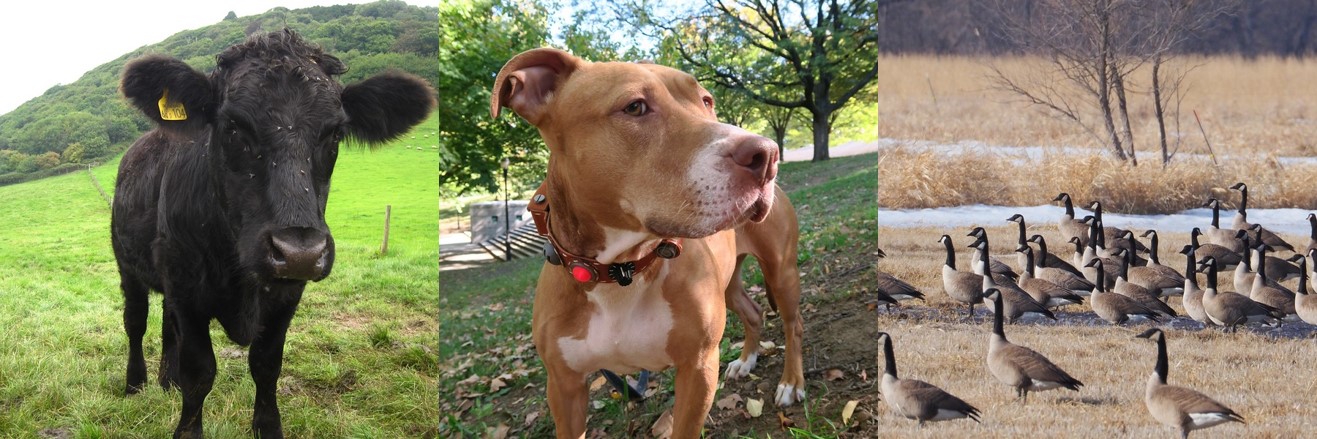This topic takes on average 55 minutes to read.
There are a number of interactive features in this resource:
 Science
Science
 Biology
Biology
Human and animal health are irrevocably linked. Often, infectious diseases are present in animals before they are passed into the human population. In recent years, many disease outbreaks have been the result of animal to human transmission; the West Nile virus outbreak in North America, avian flu, rabies, Middle East respiratory syndrome coronavirus (MERS-CoV), human immunodeficiency virus (HIV), severe acute respiratory syndrome (SARS), anthrax and Ebola1. The novel Covid-19 virus, a coronavirus, which spread across the world in early 2020, is another example of a zoonotic disease. Early evidence suggested that this virus was spread from its animal host (bats), to humans via an intermediate host (Malayan pangolins)2.
Farm animals, companion animals and wild animals can all be sources of disease that can be passed onto humans.
| Table 1. Examples of zoonotic diseases in farm, companion, and wild animals | |||
| Species | Disease in animal host | Disease in human host | Method of transmission from animals to humans |
|---|---|---|---|
| Cow (farm animal) | Bovine spongiform encephalopathy (BSE) | Creutzfeldt-Jakob disease (CJD) | Consuming infected animal products |
| Dog (companion animal) | Rabies | Rabies | A bite or scratch from an infected animal |
| Birds (wild animal) | Avian flu | Spanish flu | Genetic material from the avian flu was transferred to human infecting virus strains (reassortment) |

Creutzfeldt-Jakob disease (CJD) is a rare, fatal neurodegenerative disease in humans. It is carried by cattle, where it causes Bovine spongiform encephalopathy (mad cow disease) and is passed to humans through contaminated animal products. Since the link between variant CJD and BSE was discovered in 1996, strict controls have proved very effective in preventing meat from infected cattle entering the food chain. Furthermore, the control measures have dramatically reduced the levels of BSE in cattle, meaning that the risk posed is extremely small.
Rabies kills thousands of people a year, mostly in Asia and Africa, and infections often occur from an infected dog bite. Vaccination of dogs to prevent rabies from infecting them also has a hugely positive affect on human health, eliminating the risk that rabies infected dogs pose to human health.
The 1918 influenza pandemic, which resulted in the deaths of an estimated 50 million people, is thought to have originated in birds before changes to the virus allowed it to infect humans3.
It is important that public health authorities, food safety authorities, doctors, vets and farmers, collaborate together to prevent the spread of diseases from animals to humans taking a true ‘One Health’ approach.
There are many preventative measures that farmers and pet owners take to prevent disease, vaccination, biosecurity, good animal husbandry and good nutrition4.
Biosecurity refers to measures that are designed to protect against the spread of diseases, such as fencing around cattle fields to prevent their interaction with wild animals.
Vaccines contain a dead or altered form of the pathogen, incapable of causing disease. This introduces the body’s immune system to a particular disease antigen. An antigen is a protein on the surface of a microorganism, which can stimulate a response by the immune system. The body learns how to recognise the antigen, respond effectively to fight off the infection, and prevent the microorganism from causing damage in the future.
Vaccines initiate a response from the primary immune system, which produces antibodies against the antigen. This allows the secondary immune system to spring into action more quickly if the animal comes into contact with the pathogen a second time, preventing infection. Learn about the activity of vaccines here. More about vaccines, animals and disease prevention can be found on the following page.